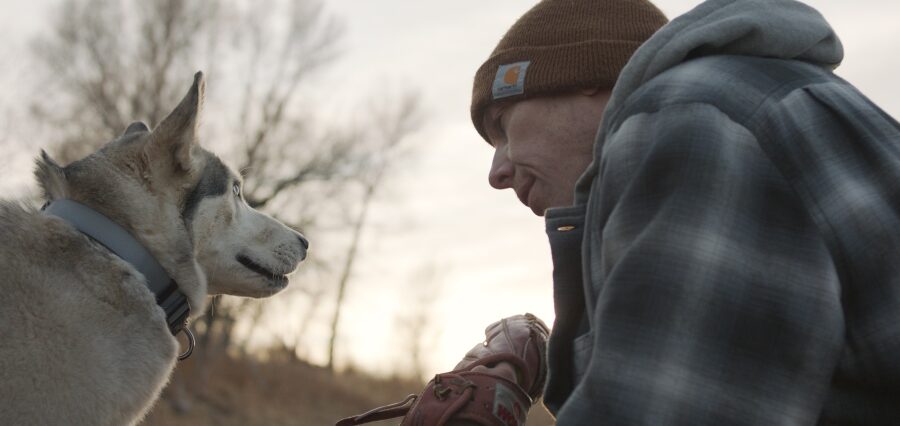“The Year of the Dog” finds audience with story of redemption, rescue
As a child in small Alaskan towns along the Iditarod Trail, Rob Grabow watched dogsleds fly past on their way to colder, even more remote environments.
Sitting still could be just as dangerous.
“I grew up around people who struggled with addiction, so there’s a part of me that wanted to honor them, because all of my mom’s closest friends were recovering addicts,” said Grabow, the writer, producer, and star of the new indie movie “The Year of the Dog.” “It’s easy for people to feel isolated or unseen, and I wanted to explore how society can hold a little bit more space for them.”
One of those people was Grabow’s childhood friend, who took his own life in Alaska in September, he said. It was a painful reminder of why Grabow started making “The Year of the Dog” during the pandemic — an otherwise quiet time in filmmaking that allowed him to snag bigger names for the project — and an example of why recovery is not only possible, but potentially transformative as well.
” ‘The Year of the Dog’ is a film about important subjects – substance abuse, the special human/canine bond, and love,” wrote Oscar winner Jeff Bridges — who, like Grabow, is lately a Montana resident — in the film’s press materials. “(It) addresses these in a skilled and informed way.”
The movie tells the intertwined stories of protagonist Matt (played by Grabow) and Yup’ik, a Husky stray with “an unusual athletic gift.” The two meet by chance after Matt moves onto his AA sponsor’s acreage to work as a handyman. It’s soon clear that Yup’ik and Matt have much to offer one another, despite both meeting at rock bottom. Matt, for his part, is struggling to stay sober at the request of his dying mother — who just wants to see him clear-headed once more before her death.
It’s a lean, measured character study that sidesteps the anguished clichés of many addiction-and-recovery movies, but also asks important questions about how far people and animals can be safely pushed. What seems like a solution is often not.
While Grabow said he has not personally struggled with addiction, his life experiences and the caliber of talent around him on “The Year of the Dog” tell a story that rings true. Indigenous actors Jon Proudstar (“Reservation Dogs”) and Michael Spears (the Paramount+ “Yellowstone” spinoff “1923”), and Broadway’s Aaron Finely (“Moulin Rouge,” “Rock of Ages”), fill vital supporting roles, but it’s Grabow and Yup’ik’s movie.
Yup’ik is played by a real-life California rescue dog named Caleb, who was passed between homes because he was “too much dog” and “too energetic,” Grabow said. That gave him an unpredictable, deeply endearing personality. Other dogs in the film came from Berthoud’s Tru North Kennels, a working- and show-dog breeder that provided Malamutes Sampson (played by the real-life dog Buckaroo Bonzai) and Joyful (real name: Joyful Mountain), as well as the mixed-breed Mars (real name: Red Rock’s Rule of Mars).
“When Matt decides to have Yup’ik pull weight (for Iditarod training), people disagree with him and say, ‘Maybe you’re putting him in jeopardy,’ ” he said. “I wanted to explore the idea of something that internally feels right, but that externally makes people question you.”
Given the Iditarod component, Grabow also tapped Terry Reed, the Colorado-based president of the International Weight Pull Association, to help bring in dogs from not only Colorado but also Michigan and Montana for relevant scenes. When “The Year of the Dog” opened in theaters in Grand Junction and Colorado Springs on Feb. 24, Grabow also partnered with Grand Rivers Humane Society and Humane Society Pikes Peak Region, respectively, to donate 5% of the net theatrical proceeds to support their cause. He did the same thing for every city the movie opened in.
That ended up being more than he had anticipated. Grabow assumed his $150,000-budgeted production would go straight to streaming platforms, but a handful of positive test screenings and national distribution allowed it to open on 100 screens simultaneously. In some markets, including the small Montana towns where Grabow shot most of the movie, it opened at No. 1 — even if that just meant 30 people per showing.
“The basic challenge of indie filmmaking is getting people to see your movie, and our goal was to have it play one commercial theater for one week,” Grabow said of the film, which became available to stream on April 7. “It was surreal to have that multiplied by 100.”
Grabow, 41, came to acting later in life. He was born in Wyoming and moved between Alaska and Montana in his youth, graduated with a finance degree from Washington’s Gonzaga University, and went on to study at The Actor’s Studio MFA drama program in New York. He took roles in indie features and shorts, with a few speaking parts in bigger projects (SyFy’s “Z-Nation,” the critically acclaimed drama “Mickey and the Bear”), and made his first short, “Method,” which won the best screenplay award after premiering at New York’s Chelsea Film Festival in 2019.
Grabow’s latest work is his biggest and best, but also his most personal. It couldn’t have been any other way, he said.
“There’s a line in the movie that basically says, ‘As I kid I moved around a lot, and when I hugged my dog it felt like everything was OK,’ ” he said. “We can’t pass over people in life because we’re looking at it in too narrow of a way. Everyone, no matter how down they are, has something valuable to offer.”
Subscribe to our weekly newsletter, In The Know, to get entertainment news sent straight to your inbox.
Source: Read Full Article


